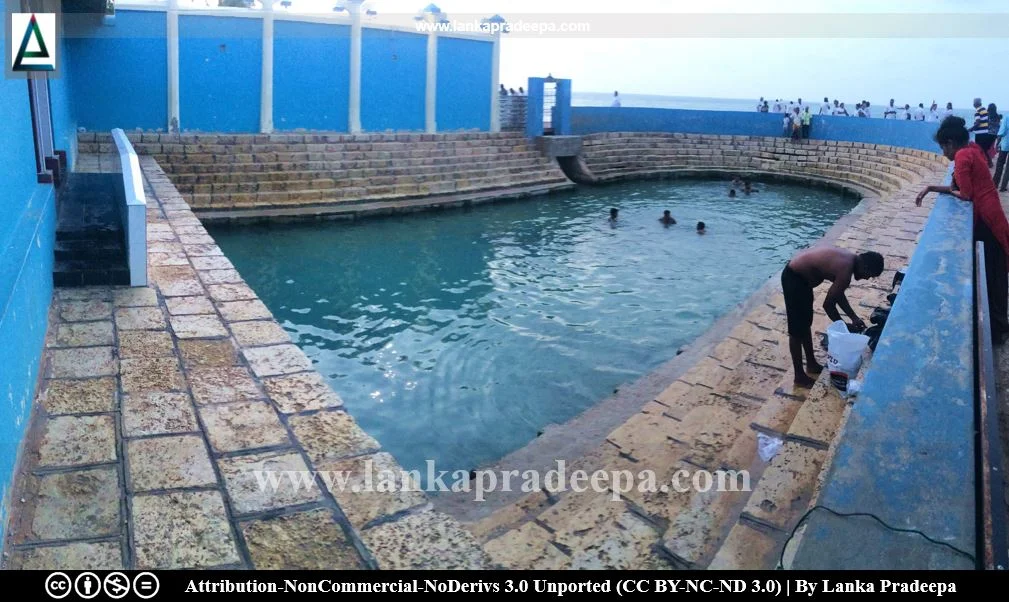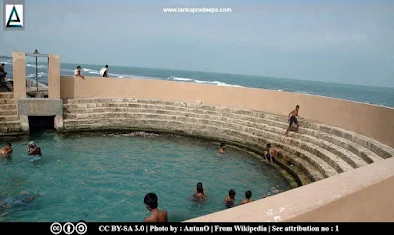
|
Keerimalai Pond |
Keerimalai Pond (Tamil: கீரிமலை நீரூற்று; Sinhala: කීරිමලේ පොකුණ), also known as Mongoose-hill Pond or Mugati Kanda Pokuna, is a bathing pond located close to the Keerimalai Beach in Jaffna District, Sri Lanka. The ancient Naguleswaram Temple is also located near this pond.
The Pond
Many freshwater springs are found mainly along the coast of the Jaffna peninsula and Keerimalai is one such freshwater spring. According to Hindu beliefs which are usually based on their traditional mystic emotions and religious literary works, the freshwater spring at Keeramalai is a holy place endowed with miraculous powers. It is believed by Hindus that bathing in the freshwater of this spring can cure various skin infections and induce childless women to achieve pregnancy (Dias et al., 2016; Wijebandara, 2014). There are two ponds at the site and one of them is covered and preserved for the use of women.
According to another belief, the springs of Keerimalai have an underground connection with the Bottomless Well at Nilavarai, a freshwater well located about 11 km away from the Keerimalai pond (Raghavan, 1971).
Legends
According to legends, the face of a priest called Yamadakkini Muni became a face of a Mongoose as a result of a curse chanted by God Siva (Wijebandara, 2014). To cure the deformed face, the priest came to Sri Lanka and bathed in this pond. It is said that after getting the bath and doing the rituals at the Siva temple, he got his human face again (Wijebandara, 2014).
As mentioned in Yalpana Vaipava Malai, a Chola princess named Marutappiravikavalli, the daughter of Thisai Yukkira Cholan, the King of Chola-thesam had a face similar to a horse (Ananthanathan, 1993; Britto, 1879; David, 2011). After hearing about the healing properties of the spring at Keerimalai from an ascetic named Santha-linkan, she came to Sri Lanka and encamped at a place which later started to be known as Kumaraththi-pallam [(the Princess Valley) Britto, 1879]. By the direction of a sage named Nakula Muni, she started to bathe in the sea at the spot where the sea receives the Keerimalai stream (Britto, 1879).
Marutappiravikavalli remained in Keerimalai for a considerable time repeating necessary rituals until the miraculous water washed away her deformity face and pain (Britto, 1879). After receiving a healthy face, she wished to build a temple for Kandaswamy (see the similar story of Maviddapuram Kandaswamy Temple) at the scene of her recovery (Britto, 1879). At her request, King Thisai Yukkira Cholan supplied her with the men and materials required for building the temple (Britto, 1879).
Maviddapuram, a locality near Keerimalai preserve some memory related to this event as its name has the meaning "Ma: horse, vidda: left off, puram: city/place" (Britto, 1879).
A Protected Site
Two Keerimale ancient ponds near Naguleshwaram Kovil situated in Keeramale village in the Grama Niladhari Division No J/226 of Naguleshwaram in Thelippalai Divisional Secretary’s Division of Walikamam North are archaeological protected monuments, declared by a government notification published on 1 February 2023.


Related Posts
Read Also
References
Books, Government Gazette Notifications
1) Ananthanathan, A.K., 1993. Temple, religion and society. East and West, 43(1/4), pp.155-168.
2) Britto, C., 1879. The Yalpana-Vaipava-Malai or The history of the Kingdom of Jaffna: Translated from the Tamil, with an appendix and a glossary by C. Britto. Colombo. pp.9-11.
3) David, K. ed., 2011. The new wind: Changing identities in South Asia. Walter de Gruyter. p.185.
4) Dias, M.; Koralage, S.B.; Asanga, K., 2016. The archaeological heritage of Jaffna peninsula. Department of Archaeology. Colombo. pp.50, 203.
5) Raghavan, M.D., 1971. Tamil culture in Ceylon. Kalai Nilayam. p.40.
6) The Gazette of the Democratic Socialist Republic of Sri Lanka: Extraordinary. No: 2317/57. 1 February 2023. p.9A.
7) Wijebandara, I.D.M., 2014. Yapanaye Aithihasika Urumaya (In Sinhala). Published by the editor. ISBN-978-955-9159-95-7. pp.129-130.
Location Map
Dynamic Google Map
Attribution
To Whom
1) Keerimalai Pond, Jaffna by AntanO is licensed under CC BY SA 3.0


